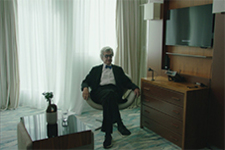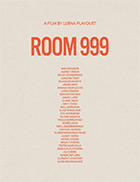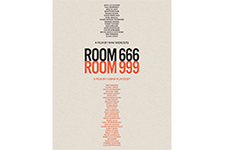Room 999 (Chambre 999)
|  At the Cannes Film Festival in 1982, German filmmaker Wim Wenders invited sixteen directors—ranging from his fellow New German directors Rainer Werner Fassbinder and Werner Herzog, to Hollywood titan Steven Spielberg and French iconoclast Jean-Luc Godard—to sit in front of a stationary 16mm camera for up to 12 minutes in a room at the Hotel Martinez, just off the Boulevard de la Croisette in Cannes, and answer the question: is the cinema “a language about to get lost, an art about to die?” At the time, the major issue at hand was the encroachment of television and home video, new media that posed an existential threat to the traditions of celluloid and widescreens. The resulting film, Room 666 (Chambre 666), one of Wenders’s first documentaries, offers a fascinating snapshot into that moment in film history, recording the hopes and fears of some of the medium’s most important practitioners. Forty years later, French actress Lubna Playoust, making her feature directorial debut, has recreated Wenders’s experiment in Room 999 (Chambre 999). Unlike Wenders in 1982, Playoust is a relatively minor player in the world of international cinema, a self-described “emerging filmmaker” who has appeared in few short films and a half dozen features and directed two shorts, Valse à trois (2014) and Le cormoran (2022). She has noted in interviews that she saw Wenders’s film as “premonitory” and was curious to see what the answers would be today. The set-up, therefore, is almost exactly the same: Recorded at the 2022 Cannes Film Festival, a roster of international filmmakers takes their place in a chair in front of a static camera in a room at the Hotel Martinez and offers their thoughts on the future of cinema. Of course, now the static camera is digital, but the filmmakers are still limited to at most 12 minutes. And the existential crisis facing the medium is no longer television and home video, but its multi-tentacles descendant: streaming. Whereas the filmmakers in Wenders’s film were flanked by a television set broadcasting whatever happened to be on at that moment (usually the French Open), the filmmakers in Playoust’s film are flanked by a flat-screen display mounted on the wall, most often displaying a range of streaming services. In both cases the screen within the screen serves as a constant visual reminder of not just what the filmmakers are discussing (often lamenting), but testament to its omnipresence.Appropriately, Playoust begins with Wenders himself, who is the first person on camera to address the same question from four decades earlier: is the cinema “a language about to get lost, an art about to die?” Wenders does not seem hopeful about the future of cinema and the role of streaming and digital technologies (the latter of which he describes as “lethal”), although there is something practical in his ultimate assessment that, even though the cinema “as the art form we knew” is disappearing, it might be “replaced by something else,” which is a constant truth of not just film history, but the history of all the arts. Some of the filmmakers are direct in their condemnation of modern shifts in digital technologies and distribution systems: Albert Serra calls streaming platforms “completely moronic,” James Gray laments how audiences are being “trained” to only watch comic book and franchise movies, and Ruben Ostlund notes how cinematic expression is narrowing in the digital age. Other filmmakers offer notes of hope and potential, including Joachim Trier, who says he wouldn’t be making films if he weren’t an optimist, and Ayo Akingbade, the youngest of the interviewees at 29, who urges optimism. David Cronenberg, the oldest interviewee at 80, says, “I don’t fear for the future of cinema,” even as he concedes that it will be a “transformed and evolved version of cinema.” And Kirill Serebrennikov, perhaps overwhelmed by the question, does not speak at all, but rather dances for the camera.Interestingly, Wenders is the only person associated with Room 666 to also appear in Room 999. Of course, of the sixteen filmmakers who appeared in his earlier film, only eight were still alive at the time Playoust was shooting her interviews, which relied on the filmmakers being present and available at Cannes. It would have been interesting to hear some of them revisit their earlier assessments, but that arguably would have created a different film, one that looked simultaneously to the past and future. Playoust is clearly most interested in what the current crop of international luminaries sees on the horizon, and the variety of responses offers its own kind of optimism, one that belies the film’s haunting central metaphor: the death of a massive Lebanese cedar tree along the highway leading from the Paris Charles de Gaulle Airport that Wenders highlighted at the beginning of his film. Killed by disease and cut down, its massive trunk lies rotting on the ground, providing an all-too-easy metaphor for the death of traditional cinema that Playoust warns us about (“It is too easy in our time,” she says in voice-over narration, “to interpret this event as symbolic”). It is an apt warning because of the ease wth which we see death, but fail to recognize the varieties of life evolving all around it. If there is any optimism in Room 999, it lies in the diversity of opinions offered by its range of interviewees: Thirty distinct voices responding to the same question in six different languages and in vastly different ways, thus reflecting in a microcosm the immense universe of human expression that will persist regardless of how sound and image is captured and distributed.
Copyright © 2025 James Kendrick Thoughts? E-mail James Kendrick All images copyright © Janus Contemporaries | ||||||||||||||||||||||||||||
Overall Rating: 

 (3)
(3)


 This Blu-ray release includes both Room 666 (1982) and Room 999 (2023).
This Blu-ray release includes both Room 666 (1982) and Room 999 (2023).